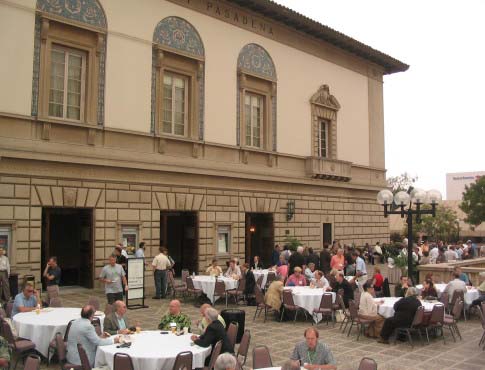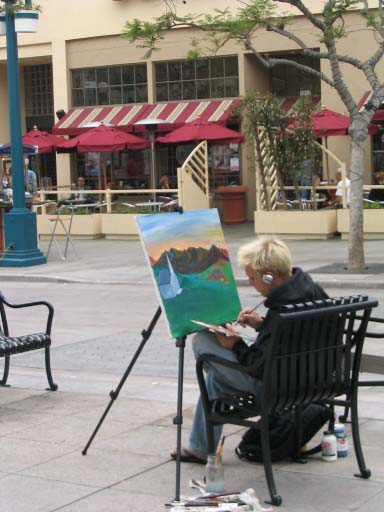| The LookOut columns |

|
What I Say | About
Frank Gruber Email Frank |
|||
|
Smart Urbanism By Frank Gruber "New urbanism" is an analytical framework for looking at land use and communities that has become remarkably influential since its proponents and practitioners began to articulate it almost 20 years ago. New urbanism and the closely related framework known as "smart growth" arguably constitute the dominant paradigm in the academic field of urban planning, and new urbanists are rapidly assuming control of public planning agencies. It's one thing to succeed in the marketplace of ideas, but even more important, new urbanism is succeeding in the marketplace itself, as large-scale real estate developers have taken notice. New urbanist thinking is attracting big-time capital to urban ventures that only a few years ago would have been incomprehensible to the banks, insurance companies and pension funds that finance real estate development. "New Urbanism" is also a movement, lead by a non-profit organization called the Congress for the New Urbanism (CNU). The CNU held its 13th annual meeting in Pasadena from last Thursday through Sunday, and I managed to take in a lot of it. For those readers who don't know much about new urbanism, the central ideas are contained in the first words of the preamble of the CNU's charter: "The Congress for the New Urbanism views disinvestment in central cities, the spread of placeless sprawl, increasing separation by race and income, environmental deterioration, loss of agricultural lands and wilderness, and the erosion of society's built heritage as one interrelated community-building challenge. "We stand for the restoration of existing urban centers and towns within coherent metropolitan regions, the reconfiguration of sprawling suburbs into communities of real neighborhoods and diverse districts, the conservation of natural environments, and the preservation of our built legacy." (To read the entire charter, go to the CNU's website)
For those readers who know about new urbanism and smart growth, but who wonder what the differences are, be assured that there is huge overlap between the two concepts and movements. Indeed, Smart Growth America, a coalition of smart growth groups (including the CNU), linked from its website to the CNU meeting website, and the Chair of the CNU, Hank Dittmar, is also on the steering committee of Smart Growth America. The small practical differences between smart growth and new urbanism are not worth a lot of column space, except to the extent the differences help understand the challenges that both movements face, including many that were subjects of discussion at the Pasadena CNU meetings. A New Urbanist purist would say that Smart Growthers are indifferent to design -- that they care about putting development where it belongs, and mixing up uses, but not enough about what the development will look like. To put this in the Santa Monica context, the New Urbanist might accuse a Smart Growther, with respect to the proposed redevelopment of Santa Monica Place, of caring only about turning the mall into a mixed use project by adding housing and offices, and not caring what form the development took. Because the destruction of the city in the 20th century was often accompanied by what is loosely called "modern" architecture, New Urbanists tend to be suspicious of certain building materials -- concrete and steel, for instance. The Smart Growther might reply that some New Urbanists are too willing to cooperate with suburban developers who gussy up with town squares and porches and some walkable density sprawling new towns that exacerbate regional problems. This is called putting lipstick on a pig. If the Smart Growther is really annoyed, he'll roll his eyes and say that new urbanists are too rigid in their approach to design -- that they're lost in nostalgia. Personally, I don't know any new urbanists or smart growthers who make a point of emphasizing these distinctions; most people I know would be happy to be known as "smart urbanists," or even more simply, as urbanists. (Since "urbanist" sounds like someone who merely studies cities, I prefer "urbanista" for those who love them.) In fact, the emphasis should be on the noun, and its root, "urbs," the city, and the effort to persuade people conditioned by lifetimes of negative images that the city is not something to be feared, but is rather, as it was until relatively recent human history, something to be loved. (Or even to be worshipped; the author Joel Kotkin, in his new book, The City, A Global History, claims that one prerequisite for a great city is to be sacred. But then Mr. Kotkin is now pushing something he calls the "New Suburbanism.")
One of the more loving, if not sanctified, presentations I saw in Pasadena was a slide show about mini-malls, the work of John Kaliski, an urban designer working in Los Angeles. Mr. Kaliski has identified five classes of mini-malls, from the most basic micro-mall (just one row of shops facing a row of parking) through the classic L-shaped mini and two-story mini's with restaurants upstairs, to even bigger versions -- one of which in the San Gabriel Valley that includes a hotel. What all mini-malls have in common, in addition to parking, is what they are not: they are not regional. They are not even subregional. They serve local markets and provide business opportunities for immigrants and other entrepreneurs. Recalling the critique of New Urbanists that they tend to be nostalgic, it's hard to imagine an urban form less congenial to them than the mini-mall, what with the cars parked out front and the huge signs. But Mr. Kaliski successfully argued that mini-malls arose from and developed spontaneously in the cultural, demographic and economic mix of L.A., without benefit of planning or ideology, and represent a new form for urbanism if not "new urbanism." To the credit of the New Urbanists who responded to Mr. Kaliski's presentation, they were open-minded, although before they would be willing to include mini-malls in their formbooks, they, along with Mr. Kaliski, thought that it wouldn't take much to improve their architecture and pedestrian access. (The zoning code might even make the smart growthers happy by encouraging a floor of apartments on the top.) Another theme discussed frequently in Pasadena was sustainability. What appears to be happening is that the entire discussion of urban form, however denominated, is becoming subsumed within a bigger discussion of how to create a sustainable society and economy. (Santa Monica, by the way, is a leader in this field.) This is a good thing, but only partly. The good is that formerly anti-growth environmentalists now acknowledge that urban density creates permanent and systematic net goods for the environment, and that cities are crucial for a sustainable future. The bad is that all this talk about sustainability threatens to throw urbanism into a Malthusian funk. What started out as a movement dedicated to reclaiming the joys of community is burdening itself and confusing its purpose with the task of solving energy and environmental problems that are not its fault. Even if there were unlimited oil and no global warming, the first job of urbanistas would be to rekindle the love of the people for the city. Oddly enough, if urbanistas do that, they will solve the other problems, too. | |||||
| |
The
views expressed in this column are those of Frank Gruber and do not necessarily reflect the opinions of The Lookout. |
Copyright 1999-2008 surfsantamonica.com. All Rights Reserved. |

